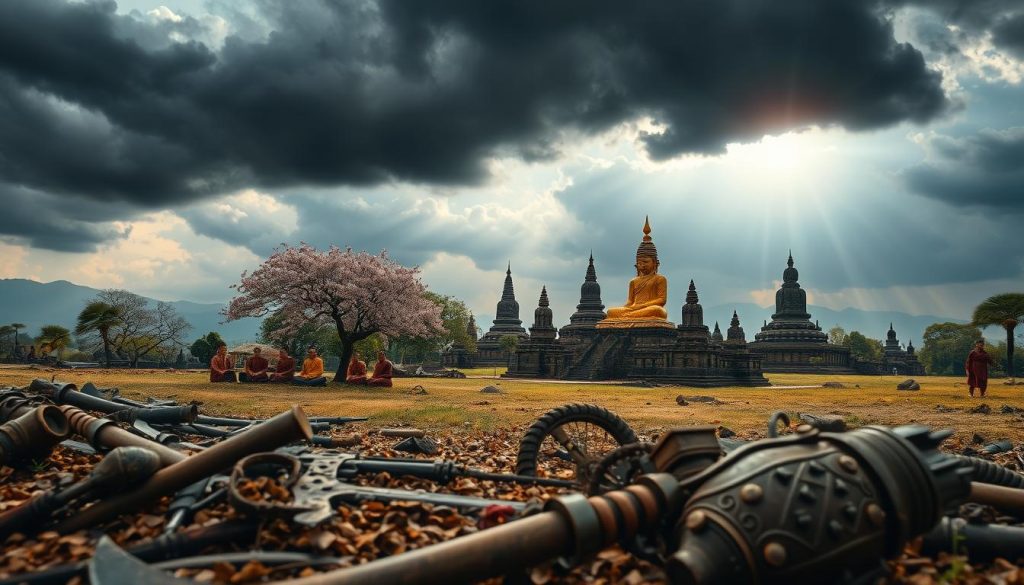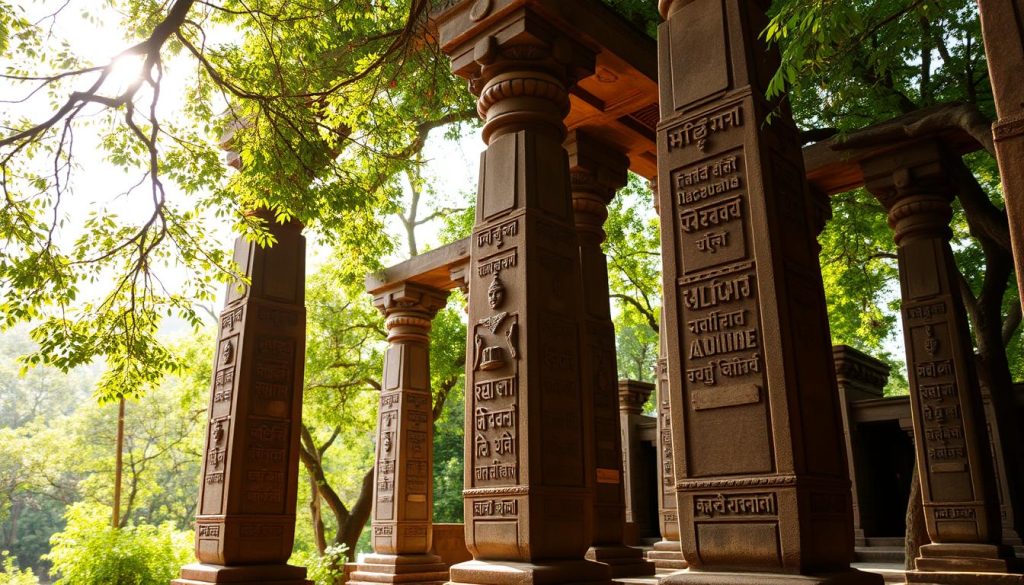Visit Bhubaneswar – Odisha’s Temple City & Cultural Hub
Imagine a city where old temples and new skyscrapers live together. Welcome to Bhubaneswar, the capital of Odisha. It’s a place where India’s past and present meet. With over 2,000 temples, it’s called the “Temple City” of India, attracting millions every year.
Bhubaneswar is more than just temples. It’s a lively city that mixes old traditions with new tech. As a “Smart City,” it shows India’s urban growth. Visitors get to see the country’s history and modern life side by side.
Key Takeaways
- Bhubaneswar is home to over 2,000 temples, earning it the title of “Temple City” of India.
- The city seamlessly combines its ancient heritage with modern infrastructure and amenities as a designated “Smart City”.
- Bhubaneswar is the capital of the state of Odisha and a hub of cultural, historical, and architectural significance in Eastern India.
- Visitors can explore the city’s rich history, admire its religious architecture, and experience its vibrant urban landscape.
- Bhubaneswar is a must-visit destination for those interested in India’s cultural heritage and the country’s urban transformation.
History and Evolution of Bhubaneswar as Kalinga’s Capital
Bhubaneswar, the lively capital of Odisha, has a rich history. It goes back to the ancient kingdom of Kalinga. The city is known for its culture and amazing buildings.
Ancient Origins and Archaeological Significance
The history of Bhubaneswar starts in the 7th century AD. It was called Ekamra Khetra, a key place for religion and government in Kalinga. Many archaeological sites in the city show its old times. They have detailed temples, sculptures, and writings that tell us a lot about its cultural heritage.
From Traditional City to Modern Smart Hub
Over time, Bhubaneswar has changed a lot. It went from a traditional city to a modern, lively place. It keeps its Kalinga history but also faces today’s challenges. Now, it’s a leading smart hub in Odisha, focusing on green growth and new tech.
Cultural Heritage Through Ages
- Bhubaneswar’s cultural heritage is a big part of the city. Its temples, festivals, and art show its lasting legacy.
- The Ekamra Khetra area, with the famous Lingaraj Temple, draws visitors worldwide. It shows the city’s deep religious and spiritual side.
- Besides its religious side, Bhubaneswar is also known for its art and literature. It’s a center for famous Odia writers, painters, and musicians. They help keep and celebrate the area’s culture.
| Period | Significant Developments |
|---|---|
| 7th century AD | Bhubaneswar becomes the capital of Kalinga, known as Ekamra Khetra |
| 11th-12th century | The city sees a golden age of temple-building, with the famous Lingaraj Temple |
| 19th-20th century | Bhubaneswar changes into a modern city, becoming Odisha’s capital |
| 21st century | The city keeps growing, taking on smart city projects and green growth while keeping its rich culture |
“Bhubaneswar is a city that seamlessly blends its ancient past with a progressive future, offering visitors a unique and captivating experience.”
Sacred Temples and Religious Architecture of Bhubaneswar
Bhubaneswar is known as the “Temple City of India.” It’s famous for its stunning religious buildings. These structures mix old architectural styles with deep spiritual beliefs. In the city’s busy streets, huge temples stand as symbols of Kalinga’s rich culture.
The Lingaraja Temple is a key landmark, built in the 11th century for Lord Shiva. This massive temple is covered in detailed carvings and tall spires. It draws both believers and tourists with its mix of spirituality and beauty.
The Mukteshwar Temple, from the 10th century, is another architectural wonder. It shows off the Kalinga style with its fancy entrance and sculptures. This temple highlights the area’s skill in craftsmanship and its deep respect for the divine.
| Temple | Architectural Style | Significance |
|---|---|---|
| Lingaraja Temple | Kalinga architecture | Dedicated to Lord Shiva, a 11th-century marvel |
| Mukteshwar Temple | Kalinga architecture | Ornate 10th-century temple, showcasing skilled craftsmanship |
Bhubaneswar’s temples and their beautiful designs show the city’s lasting spiritual impact. They invite visitors to discover the city’s rich culture and traditions.
“Bhubaneswar’s temples are not just places of worship, but living embodiments of Kalinga’s architectural genius and cultural ingenuity.”
Modern Attractions and Urban Experiences
Bhubaneswar, the capital of Odisha, has grown beyond its ancient temples. It now boasts a lively, modern vibe. Visitors can explore shopping districts, entertainment spots, and a food scene that mixes old and new.
Contemporary Shopping Districts
Shopping fans in Bhubaneswar have plenty to choose from. Janpath Market is full of handicrafts, textiles, and local goods. Esplanade One mall offers international brands and trendy shops. Here, you can find unique Odishan souvenirs and enjoy the bustling atmosphere.
Entertainment and Leisure Spots
Bhubaneswar’s entertainment scene has grown, offering fun for all. The Kalinga Stadium hosts sports events and concerts. For a calm day, Nicco Park and Botanical Garden are perfect for families to relax and enjoy nature.
Local Cuisine and Food Culture
Exploring Bhubaneswar’s Odishan cuisine is a must. Try the fish curries and vegetarian dishes at Swosti and Gokul Mistanna Bhandar. Don’t miss the famous rasagulla and chhena poda sweets. It’s a chance to taste the region’s unique flavors.
| Shopping Districts | Entertainment Spots | Culinary Specialties |
|---|---|---|
| Janpath Market | Kalinga Stadium | Fish Curries |
| Esplanade One Mall | Nicco Park and Botanical Garden | Vegetarian Dishes |
| Rasagulla | ||
| Chhena Poda |
“Bhubaneswar’s modern attractions offer a compelling blend of tradition and innovation, catering to the diverse interests of visitors.”
Natural Landmarks Around Bhubaneswar
Bhubaneswar is not just about temples and city life. It’s also home to natural wonders that make it special. Places like Bindusagar Lake, Dhauli hill, and Udayagiri Caves offer a peek into Odisha’s culture and beauty.
Dhauli Hill: A Legacy of Peace
Dhauli Hill sits by the Daya River. It’s a key spot in Indian history. Here, Ashoka, after the Kalinga War, turned to Buddhism, ending violence.
Today, the Dhauli Shanti Stupa stands as a white monument. It symbolizes Ashoka’s change and Bhubaneswar’s quest for peace.
Udayagiri Caves: A Glimpse into the Past
Udayagiri Caves are close to Bhubaneswar. They are filled with ancient history and beauty. The caves have carvings and inscriptions that show the region’s past.
Walking through, you see amazing stone carvings. The views of the landscape are stunning.
Bindusagar Lake: A Tranquil Oasis
Bindusagar Lake is in Bhubaneswar’s heart. It’s a calm spot away from the city’s noise. People come to enjoy the water, walk by the lake, and see temples.
The lake’s calm and greenery make it a beautiful place for a quiet break.
| Natural Landmark | Highlights | Significance |
|---|---|---|
| Dhauli Hill | Dhauli Shanti Stupa, Scenic river banks | Site of Kalinga War, Ashoka’s transformation to Buddhism |
| Udayagiri Caves | Ancient rock-cut carvings, Serene surroundings | Glimpse into the cultural and religious history of the region |
| Bindusagar Lake | Tranquil waters, Lush greenery, Surrounding temples | Popular gathering place for locals and visitors, Offers a peaceful escape |
These natural spots around Bhubaneswar are stunning. They show the city’s rich history and culture. From Bindusagar Lake to Dhauli Hill and Udayagiri Caves, they offer a memorable visit.
Conclusion
Bhubaneswar, the vibrant capital of Odisha, is a mix of old and new. It has ancient temples and modern sights. This city is a perfect place for those who love culture and history.
Visitors can dive into Odisha’s history, try local food, or enjoy modern Bhubaneswar. When you plan your visit to Bhubaneswar, get ready to be amazed. The city blends its heritage with the lively Odisha tourism scene.
Bhubaneswar is more than its famous temples. It’s a city where the past and present live together. It invites visitors to explore and make unforgettable memories.
FAQ
What is Bhubaneswar known for?
Bhubaneswar is called the “Temple City” of India. It has many ancient Hindu temples and beautiful religious architecture. It’s also the capital of Odisha and is now a modern, smart city. Yet, it still keeps its cultural identity.
What are some of the famous temples in Bhubaneswar?
Famous temples in Bhubaneswar include the Lingaraja Temple, Mukteswara Temple, and Parsurameswara Temple. These temples show the city’s famous Kalinga style of architecture.
What are the top attractions and experiences in Bhubaneswar?
Bhubaneswar has many attractions and experiences. You can shop in local markets, try the city’s food, and see natural spots like Dhauli Hill and Udayagiri Caves. You can also dive into the city’s rich cultural heritage.
How can I reach Bhubaneswar?
Bhubaneswar is easy to get to by air, rail, and road. It has an international airport, Biju Patnaik International Airport. It’s also reachable by trains and buses from all over India.
What is the best time to visit Bhubaneswar?
The best time to visit Bhubaneswar is from October to February. The weather is nice and perfect for seeing the city’s outdoor spots and cultural events.
What are some of the natural landmarks near Bhubaneswar?
Near Bhubaneswar, you can find Dhauli Hill, Udayagiri Caves, and Bindusagar Lake. These places let you see the city’s varied landscapes and history.
How can I learn more about Bhubaneswar’s history and culture?
To learn about Bhubaneswar’s history and culture, visit the Odisha State Museum. It has artifacts and exhibits on the region’s history, art, and religion. You can also join guided tours or local walks to understand the city’s past better.








